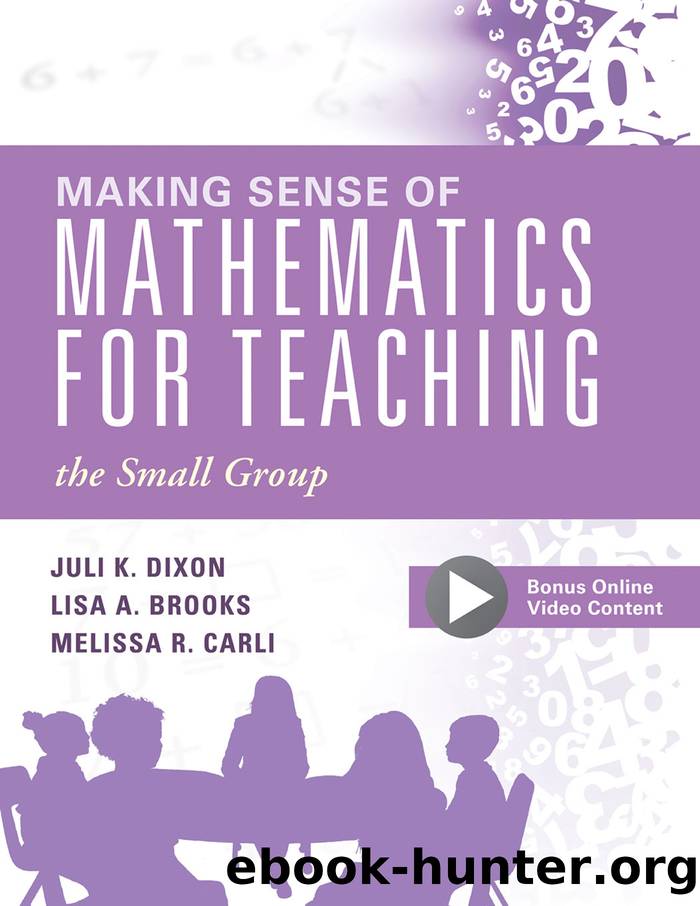Making Sense of Mathematics for Teaching the Small Group by Dixon Juli K.;Brooks Lisa A.;Carli Melissa R.;

Author:Dixon, Juli K.;Brooks, Lisa A.;Carli, Melissa R.;
Language: eng
Format: epub
Publisher: Solution Tree
Published: 2018-08-15T00:00:00+00:00
Tasks
Pulled small groups can serve many purposes; however, a learning goal should always drive those purposes. The learning goal, and studentsâ trajectories for meeting that goal, should determine the need for small-group instruction. Once a teacher has determined that small-group instruction is appropriate, he or she needs to plan studentsâ activity in that small group. We strongly encourage you to use the TQE process to support that planning. After making sense of the learning goal, the first step in planning with the TQE process is identifying a good task aligned to that learning goal.
When selecting a task it will be helpful to ask yourself, âWhat task will allow my students to engage with the learning goal?â Many teachers pay little attention to the actual task, preferring to use small-group instruction simply as an opportunity to practice solving routine computations with a preselected strategy or procedure. However, research indicates that the teacherâs role of selecting tasks and using questions to engage students with the tasks is more important than acknowledging whether studentsâ approaches to solving predictable tasks are correct (Stein, Engle, Smith, & Hughes, 2008). Tasks that ask students to perform a memorized routine limit the opportunities for students to think conceptually and make the appropriate mathematical connections, compared to tasks that create opportunities for students to think (Smith & Stein, 2011). So, how can teachers plan and implement tasks that encourage critical thinking and problem solving?
University of Pittsburgh professors of education Margaret S. Smith and Mary Kay Stein (2011) suggest five practices that teachers may adopt to facilitate productive mathematical discussions around challenging tasks. These practices are:
1. Anticipating studentsâ responses to tasks
2. Monitoring studentsâ responses as they work on the tasks
3. Selecting particular students to present their mathematical responses
4. Purposefully sequencing studentsâ responses to be displayed for the whole class
5. Helping students make the mathematical connections between and among their peersâ responses
Smith and Steinâs (2011) process can also help teachers carefully plan tasks. The first practice of anticipating studentsâ responses is important to do during the planning stage. We present a planning tool that will support you in this step later in the chapter (page 45). Once you and your collaborative team have identified possible student responses and solution strategies, monitoring studentsâ responses as they work on the tasks refers to observing your students closely to get a clear image of their current understandings. In order to move each studentâs thinking forward, select particular students within the group to share their thinking. The order in which you ask students to share their thinking and solution strategies can help guide your conversation and lead students to achieving the learning goal. Finally, providing opportunities for students to connect their own strategies and thinking to their classmatesâ will deepen their understanding of the mathematical concepts. This is done through facilitating productive discourse during the small-group instruction and will be discussed in greater detail in the next chapter (page 49). Using these five steps, teachers can anticipate studentsâ possible responses and make informed instructional decisions based on knowledge of studentsâ current mathematical thinking.
Download
This site does not store any files on its server. We only index and link to content provided by other sites. Please contact the content providers to delete copyright contents if any and email us, we'll remove relevant links or contents immediately.
Macmillan Primary Grammar 2 Pupil's Book by Unknown(409)
Figuring Out Fluency in Mathematics Teaching and Learning, Grades K-8 by Jennifer M. Bay-Williams & John J. SanGiovanni(368)
The Principal's Guide to Curriculum Leadership by Sorenson Richard D.;Goldsmith Lloyd M.;Mendez Zulma Y.;Maxwell Karen T.;(292)
Learning from Accidents 3rd ed by Trevor Kletz (2001)(255)
English Grammar Practice--The Noun by Roxana Nastase(252)
Harnessing Technology for Deeper Learning by Scott McLeod(245)
Text-Dependent Questions, Grades K-5 by Douglas Fisher & Nancy Frey & Heather Anderson & Marisol Thayre(231)
A Guide to Curriculum Mapping by Hale Janet A.;(227)
English Language Program Administration by Unknown(218)
How to Do Everything with Google Tools by Unknown(213)
Deep Change Leadership by Reeves Douglas;(208)
The Grammar Teacher's Activity-a-Day by Jack Umstatter(202)
The Power of SMART Goals by Conzemius Anne;O'Neill Jan; & Anne Conzemius(193)
Beyond the RTI Pyramid by Bender William N.;(175)
Aligning and Balancing the Standards-Based Curriculum by Squires David A.;(172)
Using Data to Close the Achievement Gap by Johnson Ruth S.;(168)
Differentiated Instructional Strategies for the Block Schedule by Gregory Gayle H.;Herndon Lynne E.; & Lynne E. Herndon(166)
Using Equity Audits to Create Equitable and Excellent Schools by Skrla Linda E.;McKenzie Kathryn B.;Scheurich James Joseph;(166)
You've Got to Reach Them to Teach Them by Schreck Mary Kim; & Schreck(158)
